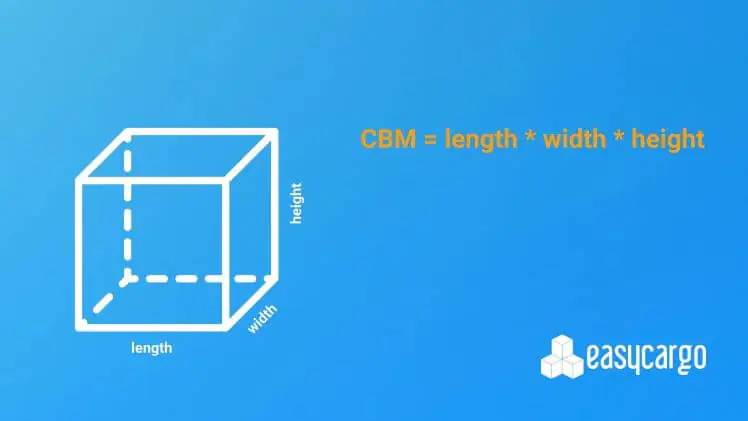CBM calculator for container shipping
Discover the benefits of using a CBM calculator for precise container load planning. Streamline your logistics operations, reduce shipping costs, and ensure optimal space utilization.

CBM calculator for container shipping
To remain efficient in logistics and the supply chain business, you must get container and trailer load planning done right before shipping. It might be easy for your staff to calculate cubic meters while shipping the same number of containers with the same number of pallets every week. However, this does not always happen, and most warehouses need to carefully calculate their container shipment before ordering the container. Otherwise, you may end up losing money, and nothing makes operation managers or freight managers more annoyed than shipping a half-empty shipping container when it doesn’t have to be that way.
Today, we’ll give examples with much closer technical aspects for calculating CBM. We’ll help navigate you so you can get an efficient and fully integrated CBM calculator and be given tips on how to avoid losing money by shipping empty shipping containers. We’re sharing and giving cost-effective suggestions on better handling and efficient space utilization for domestic and international trade. We are also sharing all that is needed to keep your international volumetric weights, length width, height, and cargo volume for container load planning in order. Let’s buckle up!
What is a CBM calculator?
A CBM (cubic meters) calculator is a digital tool used to calculate the cubic meters of the loading area. Since this is part of the shipping process, you need to manage container space as best as you can. You can load different types of containers, such as 40 ft. or 20 ft. containers, and before you schedule your cargo, you need to calculate the CBM to get a general estimate. Later, your freight admins can order the container using the correct CBM volume dedicated to shipping. It cannot be done the other way around; you need to know which container will be used. For example, the difference between a 40 ft. and a 20 ft. container is approximately 6 meters (20 ft.) in length. It’s twice as long and much more expensive, as the trailer for this container is bigger and consumes more space on streets.
The CBM calculator for load planning already has details on each shipping container in the system and all you need to do is fill in the data with the number of items to be loaded. The CBM calculator can automatically count free space in the container and give a proper estimation. What else can it do? The CBM calculator is a vast part of modern load planning software that can also visualize your container layout with each pallet or item required for transport. But we’ll share more about this later on in this article.

Why is the CBM calculator important in the supply chain?
When discussing CBM calculators for logistics and supply chains, we must mention that shipping companies use volumetric weight instead of actual weight to calculate shipping costs. Everything is based on volumetric weight, which is further calculated based on the CBM of the shipment. This is why the logistics, supply chain, and transportation industry uses CBM calculators.
With a closer look, the formula for calculating volumetric weight differs depending on the shipping company. Nevertheless, it involves multiplying the CBM by a conversion factor or agreed rate. We can figure out the value used for calculating volumetric weight when we talk about conversion factors which vary depending on the shipping company and contractual agreement.
However, we can say that this is typically a constant value that is applied to the CBM of the shipment to determine its volumetric weight. In the end, you will receive your shipping price. Below are some common conversion factors used by shipping companies:
- 300 cubic centimeters (cc) per kilogram
- 366 cubic inches per pound
- 167 cubic inches per kilogram
We can now share the first example for calculating a shipment’s volumetric weight. In the scenario below, the carrier company may want to multiply the CBM of the shipment by the conversion factor used by the shipping company. For example, if the carrier company uses a conversion factor of 300 cc/kg, and the shipment’s CBM is 1.5 cubic meters, in the end, the volumetric weight would be calculated as follows:
Volumetric weight = 1.5 cubic meters * (1,000,000 cc/cubic meter)/300 cc/kg = 5,000 kilograms
It might seem complicated, but again, if you’re using a CBM calculator like load planning software, these operations will be handled automatically. For the most part, the carrier will get the final number of CBM to know how to charge you for the shipment. You can also have direct access to carrier price lists where you can estimate costs on your own. But again, you need to know what CBM fits for your next shipment.
What is the CBM formula?
The CBM formula is calculated using a simple formula that includes multiplying length by width by height.
CBM = length * width * height
To calculate the CBM for a specific container shipment, you should know the container’s extensive dimensions. Let’s take an example with a 40 ft. and 20 ft. container as common sizes for shipping containers and estimate what kind of pallets can go into them if you have, for example, EUR pallets with a height of 78 cm.

A 20 ft. container can hold 11 EUR pallets in one tier or 9-10 standard pallets in one tier. Furthermore, height won’t play as big of a role, but if you want to load pallets on top of one another, we need to look closer at the calculation. Knowing that a 20 ft. container is up to 2.59 meters (8.5 ft.) in height, you may be able to load 22 EUR pallets, even when considering the extra sealing required, and for EUR pallets, approximately 30 cm (11.8 inches) for each pallet’s platform height.
20 ft. container CBM measurement for lower shipment cost:
- Length: 6.06 meters (19.88 ft.)
- Width: 2.44 meters (8.01 ft.)
- Height: 2.59 meters (8.5 ft.)
CBM 20 ft. container is: 6.06 m (length) * 2.44 m (width) * 2.59 m (height)
Cu ft. 20 ft. container is: 19.88 ft. (length) * 8.01 ft. (width) * 8.5 ft (height)
Looking at a 40 ft. container, we know that it can hold 23-24 EUR pallets in one tier or 20-21 standard pallets in one tier. This means that if half of the pallets are loaded horizontally, there will be less space. In fact, you should be able to fit up to 40 EUR pallets on top of one another if they’re not higher than the maximum load height of the container, which is 2.59 m (8.5 ft.). It’s more work for the forklift driver, but it should still be possible.
40 ft. container CBM calculation for sipping goods:
- Length: 12.19 meters (40 ft.)
- Width: 2.44 meters (8 ft.)
- Height: 2.59 meters (8.5 ft.)
CBM 40 ft. container is: 12.19 m (length) * 2.44 m (width) * 2.59 m (height)
Cu ft. 40 ft. container is: 40 ft. (length) * 8.01 ft. (width) * 8.5 ft. (height)
If you want to calculate the maximum number of pallets per container, you need to keep in mind that vertical and horizontal loading can provide different results. You can also mix vertical and horizontal container loading.
Below, we will share several conversion methods used for various purposes in transportation that perfectly reflect how the shipment is calculated in different regions of the world.
How do you calculate CBM (cubic meters) from cm?
To calculate CBM from cm, you’ll need to convert the measurements from centimeters to meters and then multiply them:
CBM = (Length in cm/100) * (Width in cm/100) * (Height in cm/100)
If you have a box that is 100 cm long, 50 cm wide, and 80 cm high, the calculation would be:
CBM (cubic meter) = (100 cm/100) * (50 cm/100) * (80 cm/100) = 1 m * 0.5 m * 0.8 m = 0.4 CBM
How do you convert cu ft. to CBM (cubic meters)?
To convert cu ft. (Cubic Feet) to CBM (Cubic Meters), you can use the following conversion factor:
1 cubic foot = 0.028317 cubic meters
Therefore, to convert cu ft. to CBM, simply multiply the cu ft. value by 0.028317.
For example, if you have 100 cu ft., the conversion to CBM would be:
100 cu ft. * 0.028317 = 2.8317 cubic meters

How do you calculate CBM from inches?
To calculate CBM from inches, you’ll need to convert the inches to centimeters and then convert the cubic centimeters to cubic meters.
CBM (cubic meter) = (Length in inches/39.37) * (Width in inches/39.37) * (Height in inches/39.37)
For example, if you have a box that is 12 inches long, 8 inches wide, and 10 inches high, the calculation would be:
CBM (cubic meter) = (12 inches/39.37) * (8 inches/39.37) * (10 inches/39.37) ≈ 0.0153 cubic meters
By looking at these calculations, you may notice that calculating the capacity of a shipping container might be quite time-consuming and error-prone. The number 39.37 comes from the exact conversion factor between inches and meters. We’ve reviewed only the absolute basics here without going into the calculation of a typical weekly shipment for a random warehouse. Believe it or not, this can go far beyond 50 containers per week. Even during peak season, shippers constantly calculate cubic meters to get the right rates to set up all of the shipments. As you may see, there is no way around providing effective calculations on CBM without support from software.
Load planning platforms with calculators for shipping containers
A load planning platform is designed to help logistics and supply chain companies plan their container shipments. Load planning software is commonly used in warehouses, factories, and distribution centers. Load planning platforms are typically equipped with features to bridge the gap between the loading dock and the vehicle loading space, making the process of loading and unloading goods safer and more efficient.
A load planning platform should be equipped with a CBM (Cubic Meter) calculator, which offers several advantages for businesses involved in shipping and logistics. Here are some of the key benefits:
Improved Loading Efficiency
Optimized space utilization through an accurately calculated CBM allows for more efficient packing of containers. This is how you can maximize space utilization and reduce shipping costs. Moreover, it reduces loading time. With a built-in CBM calculator in the load planning platform, workers can quickly determine the optimal placement of items within the container, and again, this is how it minimizes loading time and increases productivity.
Enhanced Accuracy and Precision
First and foremost, you can have more accurate volume calculations with a load planning platform utilizing a neat user-friendly interface. The CBM calculator ensures precise measurements. It is worth noting that it helps prevent the underloading or overloading of containers with cargo. In fact, your personnel would be making fewer errors. They can solely focus on the job, such as loading and caring for other trucks and trailers. Furthermore, a load planning platform with a CBM calculator can reduce errors. Let’s not forget that it minimizes the risk of human error in manual calculations. It all leads to fewer mistakes and improved accuracy.
Better Inventory Management
When you look at the advantages holistically, you can see that you can keep more accurate stock levels. You will know what fits into a container and how much. You can maintain accurate inventory records by tracking the freight volume of goods being loaded and unloaded. As we previously mentioned, this leads to optimized stock rotation. You can focus on efficient inventory management by identifying slow-moving or excess stock.
Lower Shipping Cost based on the CBM calculator
You can get more accurate freight charges by getting a better look at the shipping container layout because you can see shipping container space. You can simply estimate what amount is fitting into your container. You can calculate shipment costs for ocean freight, air freight, and others based on the total shipment volume of the consignment, avoiding overpayments. This feature can improve your negotiation options, as many carriers are likely to round their fees. With a load planning platform, you can request a price quote for exactly what you load. Having precise CBM data can help you negotiate better shipping rates with carriers.

Enhanced Compliance with a CBM calculator
Adherence to regulations is crucial when you handle different goods. This may require more attention and compliance with regulations. A load planning platform can help you stay informed which further ensures compliance with shipping regulations and avoids penalties for containers being overweight or exceeding the volume limits of a shipment. Load planning software can provide direct shipping documentation. It can also generate accurate shipping documentation based on CBM calculations, or you can download the information in a .CSV file for further processing.
Let’s summarize the load planning platform and CBM calculator: achieve efficient space utilization
A load planning platform equipped with a CBM calculator is essential for businesses in the shipping and logistics industry. As we said before, this can make your work way easier when loading trailers and containers. You can easily see that by optimizing space utilization, you achieve other key elements such as improved accuracy and even, to some extent, more efficient inventory management. However, all can be narrowed down to reduced shipping costs.
Think about smarter logistics and consider a load planning platform for your operations. Get your container load planning software to test for 10 days for free. Check out our shipment planning platform and benefit from lower freight costs. Contact us today to learn more about our high-quality load planning platform and how it can benefit your business.
FAQ
What is the difference between gross weight and volumetric weight?
- Gross weight: The total weight of the shipment, including the goods, packaging, and any pallets or crates.
- Volumetric weight: The volumetric weight is calculated based on the dimensions of the shipment (CBM) and a conversion factor set by the shipping company. Shipping companies often charge based on the upper end of the gross weight or volumetric weight.
How can I estimate the CBM of irregular-shaped items?
- Approximate the shape: Try to approximate the irregular shape with a simpler shape like a cube, rectangular prism, or cylinder.
- Measure the dimensions: Take the measurements of the approximated shape and use the CBM formula.
- Consider packaging: Factor in the packaging dimensions to get a more accurate estimate.
What are some additional factors to consider when calculating CBM for container loading?
- Weight distribution: Ensure the weight of the cargo is evenly distributed within the container to prevent shifting and damage.
- Hazardous materials: If you’re shipping hazardous materials, there may be additional regulations and restrictions regarding packing and stowage.
- Fragile items: Take extra precautions to protect fragile items during shipping.
Temperature-sensitive goods: Ensure that the container can maintain the required temperature for sensitive products.




